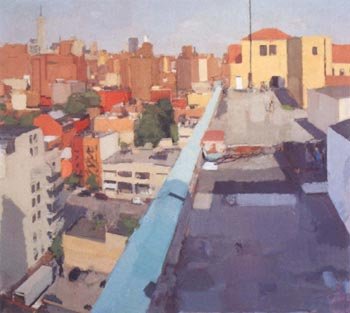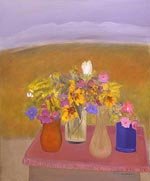
An American in Paris; Another on Long Island
John Dubrow at Lori Bookstein Fine Arts; Jane Freilicher at Tibor de Nagy
by Maureen Mullarkey
Representational painters, particularly figurative ones, are a distinct world within the larger, ever-shifting scene. They comprise a culture, one aware of its position askance of reigning fashions. They share a sense of collective purpose, recognition of common antecedents and an unapologetic love of what Kenyon Cox termed “the classic point of view.”
Within that culture, John Dubrow is something of an unofficial standard bearer for his generation. When he moved his studio to Paris in August, 2003, something essential fell from New York painting circles. It is a pleasure to have John Dubrow’s painting back in the city.
 |
| Westbeth Roof |
I expect every serious painter around will see this show at Lori Bookstein Fine Arts. They will come, as before, to inspect the quality of paint handling by an artist fluent in every aspect of representation, from landscape and cityscape to the architecture of the human figure. This time there is an added frisson: curiosity about Mr. Dubrow’s decamping to Paris, his subsequent about-face and surprising decision to leave blue-chip Salander-O’Reilly, with its imposing Old Master exhibitions for a more personal relationship with Ms. Bookstein. Exiting Parnassus for 57th Street is riskier than leaving Williamsburg for the 3rd arrondissement. But at Bookstein’s, the artist will not be competing for recognition with Tintoretto.
His move abroad began auspiciously at the prompting of Marc Fumaroli, an influential member of the Académie Française. Impressed by the artist’s last show at Salander, he invited the artist to exhibit in Paris just as the lease was up on Mr. Dubrow’s long-time studio. The artist was packing anyway; why not unpack in France? Despite introduction to leading galleries, he met Gallic resistance to representation, even to painting itself.
Convinced that painting was deader than Dieu, Parisian gallery-keeps (“Pompidou mafia” in Mr. Dubrow’s phrase), on cue from the rue du Renard, were guarded against anything that crossed their installation/conceptual Maginot Line. In New York, recurring news of the death of painting is greeted gleefully as an excuse for resurrecting it. “But in France,” Mr. Dubrow explains, “ it somehow stayed dead. Perhaps artists were intimidated by the history of painting; or maybe they naively believed the art magazines.” Creative isolation, aggravated by health and language difficulties, triggered a return to New York.
The decision was abrupt and his Paris canvases had to be finished on this side of the Atlantic. He was still painting them as the show was being hung.
There is a cool to these paintings that has less to do with Parisian light than with sangfroid. If Paris kept its distance from Mr. Dubrow, he returned the formality with a detachment of his own. Compare the muted harmonies and pared down, anonymous forms of the Parisian street scenes with the livelier color play and more individuated foreground figures of “Prince and Broadway” (2002-03). color chords are narrower and tones are adjusted with a broader, more casual sweep in these latest paintings. It is as if Parisian realities sparked involuntary withdrawal from the acquired pictorial subtleties that bind him to French painting and encouraged, instead, assertion of his origins in Bay Area figuration. It is an intriguing shift for a painter who spent hours every week at the Louvre with Poussin.
 |
| Prince and Broadway |
The chill is palpable in “Self Portrait, Paris” (2004) begun in his studio in the Marais. Unlike painters’ traditional views of themselves, the image disconcerts. Rejecting attributes of the artist at work—the easel’s edge, a brush or palette in hand—he stands with arms hanging at his sides, immobilized. The figure is locked into the picture plane by the vertical of an open doorway and a V-shaped floor line that clamps the artist like a vise. Hands are covered with gloves, prophylactic against pigment and the hazards of painting. By the door stands an undefined tan rectangle, probably a flat box but suggesting a valise. It is the portrait of a man in stasis. Or in exile.
Also on view, is the ravishing “Westbeth Roof” (2001), lovely in coloration and rigorous in construction. “Tel Aviv” (2000) is a luminous scan across the tops of homes and shops. Both paintings build on the established diagonal—dramatic in the first, more indirect in the second—that is so useful in drawing the eye into the composition. Both are incandescent, shimmering with the heat of the sun and the vitality of the paint manipulation. Smaller paintings include “Interior” (2003-04), a hieratic view of subway riders, which the artist returned to after it was last exhibited, heightening and refining. Smaller Parisian streetscapes, of the 2nd and 10th arrondisements, complete the ensemble.
Mr. Fumaroli’s catalogue essay is more fulsome than helpful—a kiss on all four cheeks. It gives a clue, indirectly, to what tortuous complexities await an American in Paris. Back in New York, John Dubrow resumes his place in the conversation between a community of painters and the longue durée of painting. It is a welcome return.




Refinement is in such short supply that I feel ungrateful to be less than wholehearted about Jane Freilicher’s show at Tibor de Nagy. Any reservation seems a sin against civility, like kicking the Queen Mother’s corgies.
 |
| Flowers on a Pink Cloth |
But disappointment sets in when you realize that, among all the delicious work in this retrospective, much of its vitality was accomplished early on. After the Abstract Expressionist juggernaut subsided, complacency set in. Work began to coast on its own prettiness, not so much living painting as a safe product for clientele anxious to display fine breeding and correct feeling.
This exhibition coincides with the publication of “Jane Freilicher,” a handsome valentine from Abrams with mash notes from Klaus Kertess, John Ashberry and Thomas Nozkowski. Illustrations from the 1950s and 60s indicate the excitement of representational painting in those decades, when it was not safe and went against the grain of the moment. That was the ground of Ms. Freilicher’s well-earned reputation.
“The Painting Table” (1954) and “Early New York Evening” (1954) build on a delightful counterpoint of light and dark tones that slowly leeches out of her work, displaced–not always, but often enough–by a mannered placidity. You see the difference immediately in the pairing of the vivacious “Still Life with Calendulas” (1955) next to “The Sun Breaks Through” (1991). The dynamic composition, dramatic color and Matissean patterning of the older painting knocks flat the newer one with its formulaic vase of flowers in front of a meadow viewed contentedly through a window, all politesse and no punch.
Look carefully at the small “Study for Winter” (1997), tucked in a corridor off the main gallery. Vibrantly handled, it is a jewel of observation and painterly lucidity that trumps canvases 8 times its size. Ms. Freilicher is a splendid painter when she is not playing safer than she needs to.




“John Dubrow” at Lori Bookstein Fine Arts (37 West 57th Street, 212-750-0949).
“Jane Freilicher: Paintings, 1954 - 2004” at Tibor de Nagy Gallery (724 Fifth Avenue, 212-262-5050).
These reviews appeared in The New York Sun , January 20, 2005
Copyright 2005 Maureen Mullarkey







